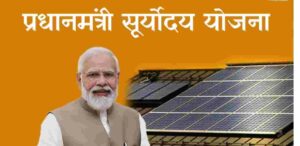India, with its commitment to sustainable development, has introduced various initiatives to harness renewable energy sources. One such groundbreaking scheme is the Pradhan Mantri Suryoday Yojana, aiming to revolutionize rural India’s energy landscape. This article delves into the intricacies of the scheme, highlighting its objectives, eligibility criteria, key features, benefits, challenges, success stories, and prospects.
Crypto Batter
- 1 Pradhan Mantri Suryoday Yojana
- 2 Importance of Solar Energy
- 3 Objectives of Pradhan Mantri Suryoday Yojana
- 4 Eligibility Criteria
- 5 Key Features
- 6 Benefits of Pradhan Mantri Suryoday Yojana
- 7 Challenges and Solutions
- 8 Success Stories
- 9 Future Prospects
- 10 Frequently Asked Questions
- 10.0.1 How can individuals or communities apply for the Pradhan Mantri Suryoday Yojana?
- 10.0.2 Are there any costs involved for beneficiaries under this scheme?
- 10.0.3 What are the environmental benefits of the Pradhan Mantri Suryoday Yojana?
- 10.0.4 How has the Pradhan Mantri Suryoday Yojana positively impacted rural communities?
Pradhan Mantri Suryoday Yojana

The Pradhan Mantri Suryoday Yojana is a government initiative that focuses on providing sustainable and affordable power supply to rural areas through the utilization of solar energy. This innovative scheme aligns with India’s broader goal of reducing carbon emissions and promoting clean energy alternatives.
Importance of Solar Energy
Before delving into the specifics of the scheme, it’s essential to understand the significance of solar energy in today’s world. Solar power is not only a renewable resource but also a clean and eco-friendly alternative to conventional energy sources. Harnessing the sun’s energy has the potential to mitigate environmental impact and reduce dependence on non-renewable resources.
Objectives of Pradhan Mantri Suryoday Yojana
A. Promoting Solar Energy
At its core, the Pradhan Mantri Suryoday Yojana aims to promote the widespread use of solar energy in rural areas. By encouraging the adoption of solar power solutions, the government seeks to create a sustainable and eco-friendly energy infrastructure.
B. Providing Reliable Power Supply
Another crucial objective is to ensure a consistent and reliable power supply in remote and underserved regions. The implementation of solar power systems not only addresses the energy deficit but also empowers communities with a dependable source of electricity.
Eligibility Criteria
A. Rural Areas Focus
The scheme primarily targets rural areas, where access to conventional electricity sources is often limited. This strategic focus aims to uplift rural communities by providing them with a clean and sustainable energy solution.
B. Criteria for Beneficiaries
To benefit from the Pradhan Mantri Suryoday Yojana, specific criteria must be met. The government has outlined eligibility requirements to identify the deserving beneficiaries who will receive the advantages of the solar power initiative.
Key Features
A. Subsidies and Incentives
One of the standout features of the scheme is the provision of subsidies and incentives to encourage the adoption of solar power solutions. Financial support makes the initial investment more accessible for individuals and communities, driving widespread participation.
B. Installation Process
The installation process is streamlined to ensure efficiency. The government has taken steps to simplify the procedures, making it easier for beneficiaries to embrace solar energy solutions. This includes technical support and guidance throughout the installation phase.

Benefits of Pradhan Mantri Suryoday Yojana
A. Economic Impact
The implementation of solar power solutions under this scheme has a positive economic impact on rural communities. It creates opportunities for entrepreneurship, as individuals can explore businesses related to solar energy, fostering economic growth.
B. Environmental Advantages
Beyond the economic benefits, the environmental advantages are substantial. Solar power is a clean energy source, contributing to the reduction of carbon emissions and environmental degradation. The scheme’s focus on sustainability aligns with global efforts to combat climate change.
Challenges and Solutions
A. Infrastructure Challenges
Implementing solar power solutions in rural areas comes with its set of challenges, primarily related to infrastructure. However, the government is actively addressing these challenges through strategic investments and technological innovations.
B. Government Initiatives
To overcome hurdles, various government initiatives are in place. These include capacity-building programs, research and development investments, and collaborations with the private sector to drive innovation and sustainable solutions.
Success Stories
A. Positive Impact on Communities
The Pradhan Mantri Suryoday Yojana has already demonstrated positive impacts on rural communities. Access to reliable electricity has enhanced the quality of life, opening avenues for education, healthcare, and overall community development.
B. Improved Quality of Life
The success stories emerging from the implementation of this scheme showcase improved living standards. With a consistent power supply, individuals can access modern amenities, leading to enhanced well-being and increased opportunities for personal and professional growth.
Future Prospects
A. Expanding the Program
As the Pradhan Mantri Suryoday Yojana gains momentum, there are plans to expand the program to reach more remote areas. This expansion will bring the benefits of solar energy to a larger population, contributing to the government’s vision of an energy-independent and sustainable India.
B. Potential Advancements in Solar Technology
The prospects of the scheme also involve embracing technological advancements in solar energy. Research and development efforts are underway to enhance the efficiency and affordability of solar power solutions, ensuring continuous progress in the field.
In conclusion, the Pradhan Mantri Suryoday Yojana stands as a beacon of progress in India’s pursuit of sustainable development. By empowering rural communities with clean and reliable energy, the scheme not only addresses immediate energy needs but also contributes to long-term environmental and economic sustainability.
Frequently Asked Questions
How can individuals or communities apply for the Pradhan Mantri Suryoday Yojana?
Individuals and communities can apply for the scheme through designated government channels. Details about the application process and eligibility criteria are available on the official government website.
Are there any costs involved for beneficiaries under this scheme?
While there might be some initial costs, the government provides subsidies and incentives to make the adoption of solar power solutions more affordable for beneficiaries.
What are the environmental benefits of the Pradhan Mantri Suryoday Yojana?
The scheme contributes to environmental conservation by promoting clean energy and reducing reliance on non-renewable resources, thus mitigating the impact of climate change.
How has the Pradhan Mantri Suryoday Yojana positively impacted rural communities?
The scheme has positively impacted rural communities by providing them with a reliable source of electricity, leading to improved living standards
1 thought on “Pradhan Mantri Suryoday Yojana: Empowering Rural India with Solar Energy”